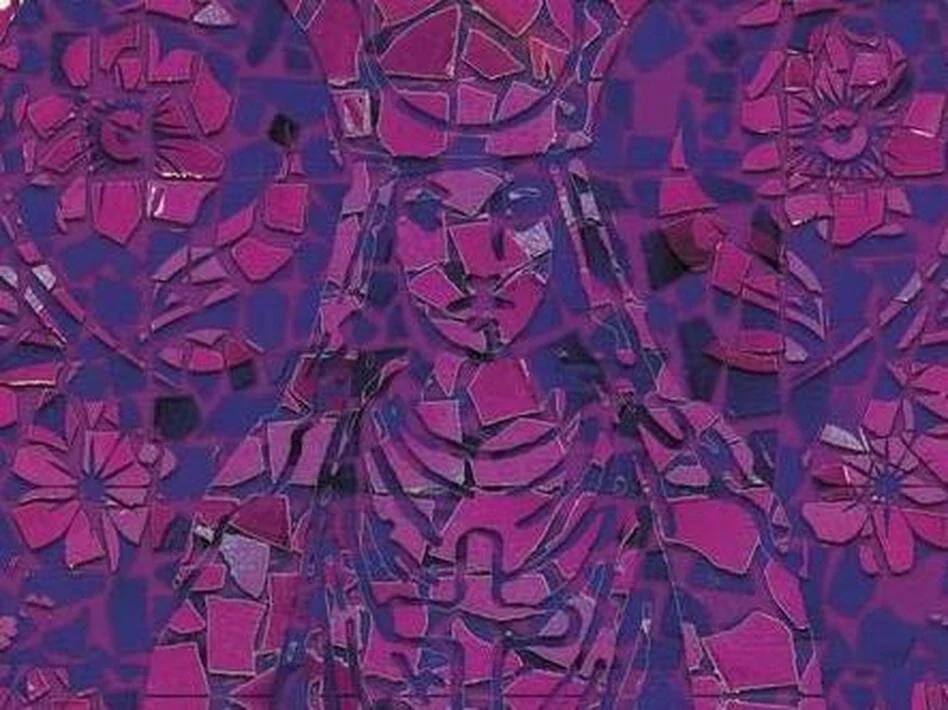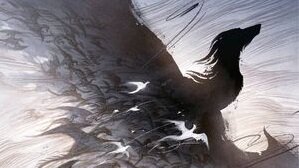By the time Blackfish City starts, the apocalypse has come and gone. Sam J. Miller’s new novel pictures urban civilization slowly recreating itself on Qaanaaq, a floating city on the Arctic Circle. Powered by geothermal energy, built by shadowy real estate moguls, and run by a legion of AI bureaucrats, Qaanaaq is a utopian-dystopian New York City on the other side of geocatastrophe. Filled with diverse, vividly drawn characters, the novel centers on a mysterious stranger, a woman who comes to town with an eerily cooperative orca and a polar bear in tow ...
Theodore McCombs: In the month it’s been out, Blackfish City has gotten a lot of praise for its richly imagined Qaanaaq, the post-apocalypse city built on oil rig platforms. Miller carefully details Qaanaaq’s rich/poor divide through housing and real estate, which makes perfect sense: Miller, a fair housing advocate, knows that’s how it works in New York, and how it will inevitably play out in any strictly bounded city that can’t sprawl. But my favorite bit of world-building is how we get that lived-in feel of Qaanaaq through the recreation people take to, or don’t: City without a Map, an underground podcast; a daredevil subculture of “scalers” who jump roof to roof over jenga-stacked slums; or beam fighting, MMA on pylons, which I can’t help but picture as pro-bending, or the Xena pilot’s masterpiece bamboo fight:
CS Peterson: Miller spends early chapters on character set-up and world-building, and there is a lot to set up. A prologue introduces the Orcamancer, a silent warrior woman named Masaaraq. Subsequent chapters switch between Fill, a trust-fund kid who has just discovered he’s contracted a fatal STD, “the breaks,” which drives the host insane with vivid memories of previous carriers; Ankit, a conflicted political operative fighting breaks denialism; Kaev, who throws beam fights for the local crime boss; and Soq, a young nonbinary messenger who flies down maglev slideways at astonishing speeds shouting “Fuck out the way!” Their voices come at you four or five pages at a shot, building up a mosaic of Qaanaaq City with all its layers, physical and social.
It’s lively and intriguing enough. Miller is a fine writer, so we trust that he will bring it all together. But there really isn’t any action until we get to the first chapter told from Masaaraq’s POV, a hundred-plus pages into the book. Once we start riding with the orcamancer, the pace really picks up.
TM: Masaaraq is a product of “nanobonding”—she and the orca are deeply emotionally linked, so that their sensations, consciousnesses and wills bleed into each other. Nanobonded persons were a pharmaceutical experiment gone sideways, then a cohesive minority culture, and finally, the victims of religious pogroms, which Masaaraq miraculously survived.
CP: That religious bigotry shows up again in Qaanaaq, and our first good look at Masaaraq has her wordlessly slaughtering the mob that came to kill her, without breaking a sweat, River Tam style. My first reaction was, here is another wild raging girl who doesn’t speak. But Masaaraq is not a little girl. She is a mature woman who is never taken for granted or overlooked by other characters. Could a new pattern be emerging: not Madonna or whore, but avenging angel? Vengeful women—from Medea to Circe—don’t fare well in myth, but in Blackfish City we’re all rooting for Masaaraq at the end. Is it possible that we are entering a new literary phase where the characters on the retributive justice end of the continuum of female rage (or the rage of the disenfranchised in general) are not censured out of hand?
TM: That scene felt extremely of our time. I feel Buffy would have beat everyone up, but not killed anyone, for example. But in a number of contemporary anti-racist and anti-sexist movements, there’s a disinvestment in restraint, civility, the benefit of the doubt; despite the hand-wringing over it, it’s based on a recognition that “civility” is too often a fig leaf for accepting the status quo of racial and sexual violence. So there’s a certain thrill of going too far in hitting back, of crossing a line of decency, even humanity. Masaaraq embodies that moral vertigo: civil norms have not produced just results, have enabled more, unidirectional violence—so screw ‘em.
CP: It grows from a sense of the system being rigged, right? Since each group experiences a denial of justice, all sides feel justified in norm-breaking. When the word on the street is that the anonymous, insulated group of city shareholders are deliberately keeping empty apartments off the market, then criminality and revolt seem only fair. Qaanaaq has the feel of a gritty 80s New York City, what with the rampaging epidemic and unscrupulous real estate barons. That led me to cast Blackfish’s shareholder antagonist, Podlove, in a Trumpian light. But, on reflection, he’s more a Bannon: from the shadows, he deploys trolling, divisive grievance-airing, and vilification of “others” to keep the population from uniting against the real powerbrokers. Miller’s villain is a manifestation of that zeitgeist.
TM: There’s a fantastic passage late in the book on money as the oldest artificial intelligence, recasting the Invisible Hand of liberal economics as a protocol of self-preservation:
Money is a mind, the oldest artificial intelligence. Its prime directives are simple, its programming endlessly creative. Humans obey it unthinkingly, with cheerful alacrity. … City Hall, [Qaanaaq’s] collective of artificial intelligences, is a framework of programs constructed around a single, never explicitly stated purpose: to keep Money safe.
Our cultural fascination with rogue AIs reflects an intuition of systemic injustice, that what we’re fighting is not one villain but a system of incentives that has taken on a life of its own. Alexander Chee’s The Queen of the Night did something similarly exciting, recasting systems of class and gender inequality in 19th-century operatic notions of Fate.
CP: The power of a simple rule to yield wildly different outcomes based on tiny differences in initial conditions can feel like the hand of a god—but it’s only math. There’s a fun interactive built by vi hart and nicky case on how neighborhoods segregate based on tiny preferences for, or against, difference. Click to play:
In the Polygons game, you can figure out the percentage of tolerance needed for naturally desegregated neighborhoods if you start with a random distribution of your little shapes. That feels pretty hopeful, until you try it starting with neighborhoods that are already segregated, then it seems almost impossible.
TM: What do you do, then, when the injustice is cooked into the system, and not the fault of any one villain? Burn it all down and start over?
CP: Blackfish suggests that new city will only recreate the same systemic imbalances. It’s an old problem. In Aristophanes’s comedy The Birds, two clowns decide to leave Athens because it has so many problems. They make a utopia with the birds called Cloud Cuckoo Land. When others hear about the paradise, they come in hordes and Cloud Cuckoo Land threatens to become another Athens, with all the same conflicts. The problem is not the place; it’s in us.
TM: Miller seems to prescribe an old remedy: Only connect. “Stories are where we find ourselves, where we find the others who are like us.” Only exposure to each other’s stories can cut through the division-mongering that keeps the shareholders in power.
CP: Yes! I’ve been seeing a new magic trope in recent fantasy. I’d like to propose a “Kum ba yah” magic of connection category for the TVTropes website. I’ve seen it pop up in Dirk Gently’s Holistic Detective Agency’s rave in the barn, in Children of Blood and Bone’s orisha community building across time and space, and now here in the contagious breaks of Blackfish City. The tribal fracturing and circle-the-wagons mentality of American society has made all efforts at dialogue appear hopeless, even in fiction. A magic spell, or plague that forces characters into the POV of those they refuse to see, is all that is left. It feels like our storytellers are all throwing up their hands.
TM: But Blackfish isn’t suggesting anything sentimental, rather the radical connection of nanobonding or the breaks: an extreme of empathy that is almost violence, almost insanity. The breaks is pretty clearly a speculative reexploration of AIDS in the 80s-90s. It’s a terrible plague that, even as it devastates a population, molds the survivors into a political force.
Miller’s short stories “The Heat of Us” and “Angel, Monster, Man” likewise circle around this sublime, terrifying potential—what kind of power forms out of communal suffering. It’s not quaint, and it’s not safe. No spoilers, but Kaev and a certain polar bear drive that lesson home very effectively. If it’s real connection, it’s never safe.
CP: And in Blackfish City, Miller takes real risks in storytelling. That’s what’s made the Art of Starving so effective, and this novel too.












In this final novel of The Daevabad Trilogy, Ali, Nahri, and Dara are morally challenged beyond endurance by the rise of death magic in their beloved kingdom. How they respond changes everything.